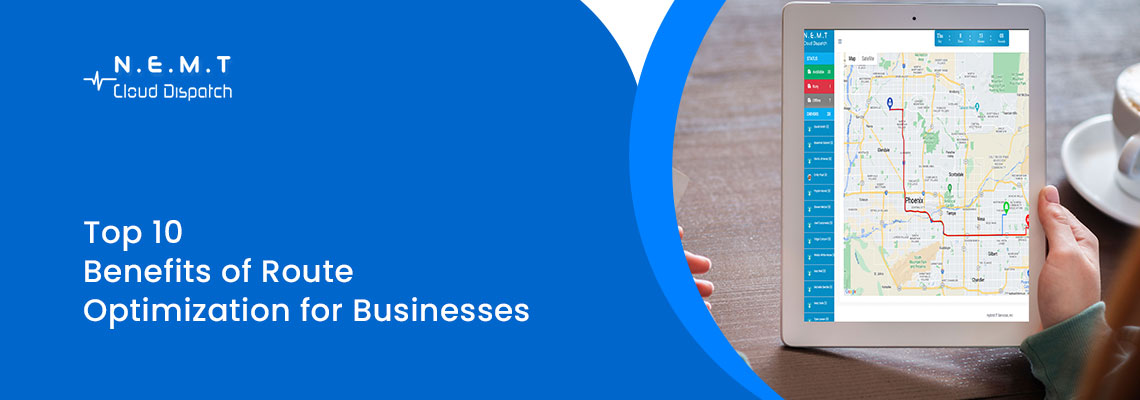In today’s fast-paced world, efficiency is key to success in any industry. This is especially true for businesses that rely on transportation, such as delivery services, logistics companies, and non-emergency medical transportation (NEMT) providers. Route optimization is a powerful tool that helps these businesses streamline their operations, reduce costs, and improve service quality.
By using advanced algorithms and technology to determine the most efficient routes, companies can maximize productivity and minimize wasted resources. This article will explore the concept of route optimization, its top benefits, and how it can transform transportation-based businesses.
What is Route Optimization?
Route optimization is the process of determining the most efficient way to travel from one location to another, considering various factors such as distance, traffic, road conditions, delivery windows, and vehicle capacities. This is achieved using NEMT Routing Software that analyzes multiple variables to create optimal routes for drivers. The goal is to reduce travel time, fuel consumption, and operational costs while improving service reliability and customer satisfaction.
Key Benefits of Route Optimization
1. Reduced Fuel Costs
One of the most immediate and tangible benefits of route optimization is the reduction in fuel costs. By planning the most efficient routes, vehicles spend less time on the road, use less fuel, and therefore reduce overall fuel expenses. This is particularly significant for businesses with large fleets or long-distance travel requirements.
You May Also Read: How Routing and Dispatching Software Can Save You Money
2. Improved Delivery Times
Route optimization helps ensure that deliveries are made in the shortest possible time. By avoiding traffic congestion, road closures, and other delays, businesses can meet delivery windows more reliably. This leads to higher customer satisfaction as clients receive their goods or services promptly.
3. Increased Productivity
Efficient routes mean drivers can complete more deliveries or service calls in a given time period. This boosts productivity, allowing businesses to handle more orders without needing additional vehicles or staff. Ultimately, this leads to increased revenue and profitability.
4. Enhanced Customer Satisfaction
When deliveries are made on time and as promised, customer satisfaction improves. Route optimization ensures that businesses can provide accurate delivery estimates and adhere to them, which builds trust and loyalty among customers. Satisfied customers are more likely to return and recommend the service to others.
5. Lower Maintenance Costs
By reducing the amount of time vehicles spend on the road and optimizing routes to avoid poor road conditions, route optimization helps decrease wear and tear on vehicles. This leads to lower maintenance and repair costs, extending the lifespan of the fleet and reducing downtime.
6. Better Resource Utilization
Route optimization allows for better utilization of available resources. Vehicles, drivers, and fuel are used more efficiently, which can reduce the need for additional investments in these areas. This helps businesses manage their resources more effectively and sustainably.
7. Environmental Benefits
Reducing fuel consumption and optimizing routes also have positive environmental impacts. Lower fuel usage means fewer emissions, which contributes to reduced air pollution and a smaller carbon footprint. Businesses can enhance their reputation by adopting environmentally friendly practices.
8. Real-Time Adjustments
Advanced route optimization software can make real-time adjustments based on changing conditions, such as traffic, weather, or last-minute delivery changes. This flexibility ensures that routes remain efficient throughout the day, minimizing delays and disruptions.
9. Enhanced Safety
Optimized routes can improve driver safety by avoiding dangerous roads, heavy traffic, and hazardous conditions. By ensuring that drivers take the safest and most efficient paths, businesses can reduce the risk of accidents and improve overall safety for their employees.
10. Data-Driven Decisions
Route optimization software provides valuable data and insights into transportation operations. Businesses can analyze this data to identify trends, monitor performance, and make informed decisions to further improve efficiency and service quality. This data-driven approach helps businesses stay competitive and responsive to changing demands.
You May Also Read: How Does Software Builds Routes: A Guide to Efficiency
How NEMT Cloud Dispatch Delivers Efficiency, Savings, and SatisfactionConclusion:
NEMT Cloud Dispatch offers a multitude of benefits for transportation-based businesses, from cost savings and increased productivity to improved customer satisfaction and environmental sustainability. By leveraging advanced technology to plan and adjust routes efficiently, companies can enhance their operations and gain a competitive edge in the market.
Whether it’s reducing fuel costs, meeting delivery windows, or ensuring driver safety, route optimization is a critical tool for any business looking to maximize efficiency and profitability. As technology continues to evolve, the capabilities and advantages of route optimization will only grow, making it an indispensable part of modern transportation management.


